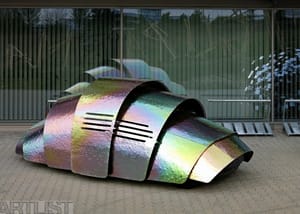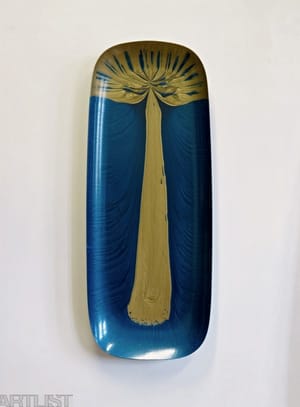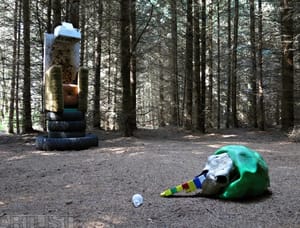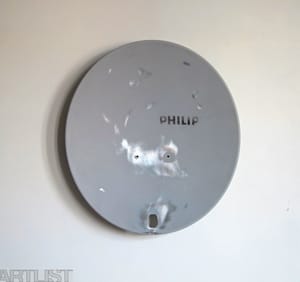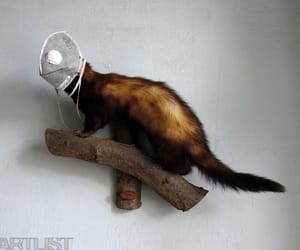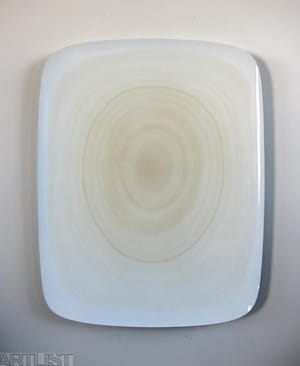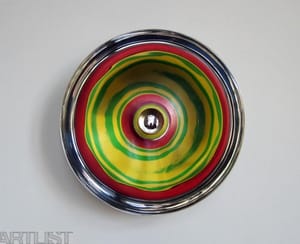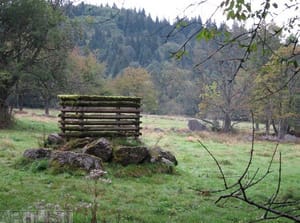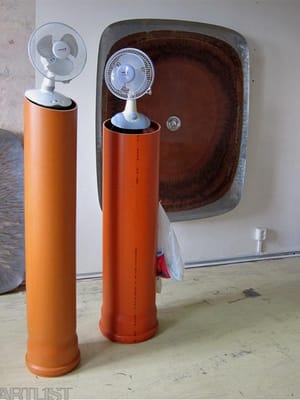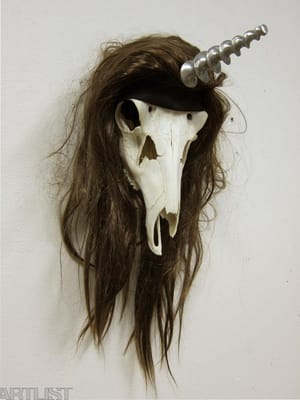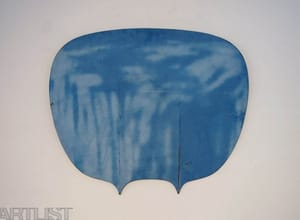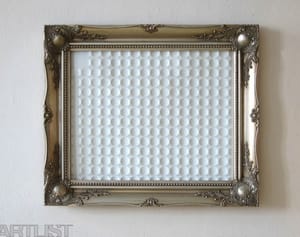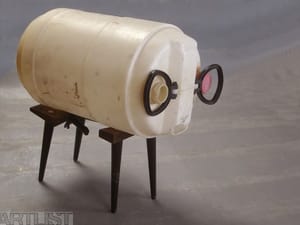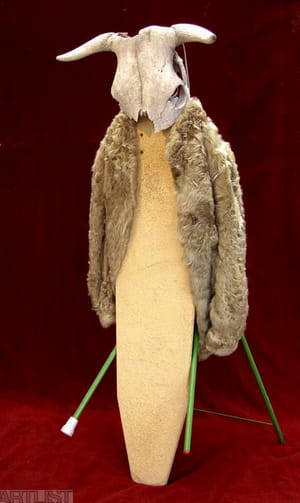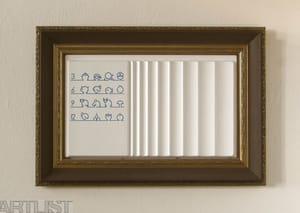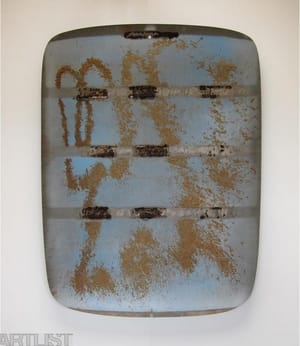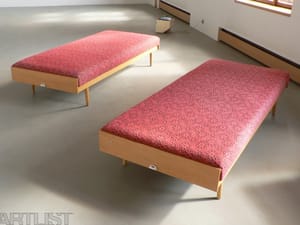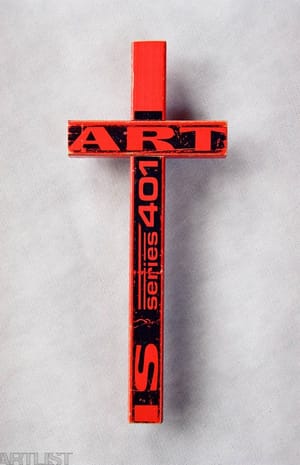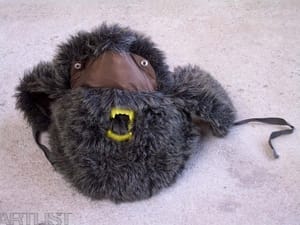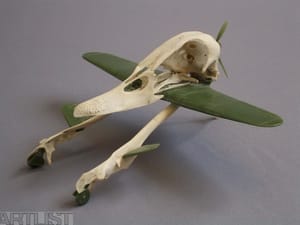- First Name
- Benedikt
- Surname
- Tolar
- Born
- 1975
- Birth place
- Plzeň
- Place of work
- Plzeň, Manětín
- Website
- tolarbenedikt.com
- CSU Library
- ↳ Find in the catalogue
About artist
The work of the sculptor Benedikt Tolar is characterised by a non-violent play making reference to sculpture, and by a cutting humour. This is usually created by the recycling and re-contextualisation of waste or found material. Though the results of his work are close to object, the sculptural background is always clear. Tolar sometimes works in the countryside on land-art installations, e.g. Ark (2011), Blinker (2011).
Tolar has long been working with the comic utilisation of readymades that he combines and transforms into bizarre figures. The beings from the series Menagerie (2000–2011) can be seen as the result of a child’s intuitive game but with a significant admixture of creative intent. Tolar reinvents found materials, finding in them figural motifs and combining them with other waste, leather, bones, etc. These poorly stuffed creatures are made magical using the minimum of material and the artist’s figural conviction. Nevertheless, in their construction we find a certain element of deconstruction and lack, and this gives rise to amusement and embarrassment. A typical example would be Beds (2004), in which Tolar interpreted the screws on a bed frame as eyes and added rubber vampire-like teeth in the centre. This inconspicuous intervention, Kovanda-like in style, significantly changed our perception of an everyday object.
A similar approach to that adopted in Menagerie is to be found in the series Bones (2001–2010) and Figures (1999–2010). All three share a playful and ironic spirit of ingenuity and individual works are linked in a cycle by their formal aspects. Menagerie processes animal motifs, Bones works with a fragment of bone and skull, and Figures with a representation of the human body. These cycles were created over a period of approximately ten years. They were not created in a continuous timeline, but were dependent on the artist discovering suitable materials and defining new functionalities for them.
Bones works on the aspect of modelling. Model I (2001), II (2001), III (2001) are DIY models of aeroplanes and helicopters in which we find a combination of fragments of toys and animal bones. The pseudo-machines then connect technology and the prehistoric hint of skeletal structures. It is for the viewer to decide whether to perceive them as autonomous functioning object-toys or the prototypes of larger works. In Bones there is the prick of a melancholy sarcasm in the form of Last (2010) and Noubady (2008). Noubady is a figure made of an ironing board dressed in a fur coat, and it is remarkable how this synthesis, along with a skull, can create such an emotional impression.
The most astringent feature might be the physical emptiness of Figures, where the human characters admirably accept inanimate items. The form of a person is unquestionable, though has the character of a deflated balloon. Though we may if we like interpret this as connoting the emptiness of contemporary society and the impossibility of enthusiasm and pleasure, the sculptures themselves are full of good cheer and comprehensibility. An almost renaissance elegance of lovers is present in the installation Sencor & Ufesa (2010), in which the names of the lovers are borrowed from the brand names of ventilators. The fact that these formal games are not childish but justified as ideas can be seen, for instance, in Head XXIII (2002), derived from Catch 22 by Joseph Heller.
A greater focus on a particular formal element and the variation thereof is present in the cycle of objects Crosses (2004–2012). This is also the moment at which an earlier intentional infantilism is transformed into a more cultivated play. The symbol of the cross is formed by pieces of wooden hockey sticks. Despite the simplicity and clarity of the visual symbols, the work is open to different interpretations. As well as linking fragments of a piece of sports equipment into the shape of a cross, inscriptions appear on the object such as art, brother, professional, team, which are the remnants of the original inscriptions on the hockey stocks. There is a hint of pop-art in this series thanks to the clear symbolism of well known motifs and the expressive colour scheme of the inscriptions. This reference to pop-art continues in the series Fridge I, II, III.
Fridge III (2008–2009) comprises an assemblage of found components of refrigerators placed within mostly ornamental frames. Unlike Tolar’s earlier work, this series is formally more cultivated without losing the earlier ironic distance. If we overlook the frames, the relief of the images is geometrically structured and reminiscent of a minimalist abstract work. However, the stylistic purity is sometimes violated by the descriptive illustrations of types of food, which serve as instructions to storage in the fridge. The transcendental level is thus disrupted by purposefulness, which transfers the abstract objects back into the sphere of the everyday. Again, this is carried out by means of humour.
The flatness and abstraction of form in Fridge continues in the sculptures of the series Auto-moto (2009-2011). Tolar continues to use found material, in this case car bonnets. However, formally these sculptures are completely abstracted, extracted from their original function and transformed into artistic objects that create new content. It is far subtler work with readymade and sees the development of a painterly sensitivity to work with surface. The cycle of sculptures Roofs (2007–2013) is directly linked to Auto-moto and takes the roofs of car bodies and installs them on a wall. Tolar leaves the trucks and cars to the fate of cabriolets and their roofs collected as trophies. Painting again makes an appearance. Several roofs are painted in different layers of colour and the surface is then sanded in such a way that a kind of graphic depiction of the contours emerges. Baths (2013-2015) and SAT-ANT (2013-2015) continue this theme, simply using different materials, namely parts of a van, satellites and television antennae.
- Author of the annotation
- František Fekete
- Published
- 2015
CV
Studies:
since 2010
Faculty of Design and Arts Ladislav Sutnar Pilsen, studio and Sculpture Space, an assistant professor
2006–2007
VOŠUP Sand, educator
2005–2010
Institute of Art and Design in Pilsen, studio and Sculpture Space, an assistant professor
2001–2002
Campanus elementary school, teacher
1996–2002
Academy of Fine Arts in Prague, studio of Charles Nepraš Vladimir Skrepl
Internships, creative residencies:
2012
Tour Seegmuller, project - LA ZONE, Presqu'ile Malraux, Strasbourg, France
Awards:
2008
Price 333 Ng and CEZ Group, finalist
Exhibitions
- Solo exhibitions
-
2014
Na plech, Galerie města Plzně, Plzeň
2013
Země nepřátel, spolu s B. Motlovou, Galerie bratří Špilarů, Domažlice
2012
Zdroje a vazby, spolu s Renatou Kocmanovou, Blue Cat Gallery, Cherson, Ukrajina
2011
Odpouštění, Galerie Pecka, Praha
2011
Kráva zajíce nedohoní, spolu s Denisou Krausovou, Galerie Chodovská tvrz, Praha
2010
Zvenku i zevnitř, spolu s Luďkem Míškem, Univerzitní galerie, Plzeň
2010
Trofeje, Galerie U Dobrého pastýře, BKC, Brno
2008
Příbytek, nábytek, dobytek.., Galerie Petrohrad, Plzeň
2005
Divočina, Galerie ad-astra, Kuřim
2003
Bez názvu, Prostor pro jedno dílo, Pražákův palác Moravské galerie v Brně
- Group exhibitions not included in ARTLIST.
-
2015
Budelip, v rámci projektu Zen Plzeň, náměstí Emila Škody, Plzeň
2015
Od podlahy, Galerie Emila Filly, Armaturka, Ústí nad Labem
2015
Ze středu ven, K 13 Kunsthalle, Košice, Slovensko
2014
Who is the director?, festival 4+4 dny v pohybu, Palác u Stýblů, Praha
2014
Ze středu ven, Západočeská galerie, Masné krámy, Plzeň
2012
Šumavská reflexe, Galerie města Plzně, Plzeň
2012
La zone, Tour Seegmuller, Presqu'ile Malraux, Štrasburg, Francie
2012
Skulpturen - sommer, Botanischen Garten, Ulm, Německo
2012
Odnikud nikam, pro nic za nic, blízko hranic, Klášterní kostel sv. Antonína Paduánského, koncertní a výstavní síň, Sokolov
2012
Věznice - místo pro umění, Moravská galerie - UMP muzeum, Brno
2012
Hraniční polohy tradice, Kvalitář, Praha
2012
Nezvaný host, galerie Chodovská tvrz, Praha
2012
Pilsner schaum, Cordonhaus, Cham, Německo
2011
Věznice - místo pro umění, Centrum současného umění DOX, Praha
2011
Pozdní sběr, Botanická zahrada, Praha
2011
Plzeňská pěna, KGVU - Dům umění ve Zlíně, Zlín
2011
Plzeňská pěna, Galerie města Plzně, Plzeň
2011
Ladový hokej, Múzeum V.Löfflera, Košice, Slovensko
2011
Pilsner schaum, Kunstverein Weiden,Weiden, Německo
2011
Ohrožený duch, galerie Tic, R2, Brno
2010
02:15, Topičův salon, Praha
2010
Fair play, Starý pivovar, Brno
2009
Böhmen liegt am meer (II), Tschechisches Zentrum, Berlín, Německo
2009
X + X 09, Oberpfälzer Künstlerhaus Schwandorf-Fronberg, Německo
2009
Böhmen liegt am meer,Städtischen Galerie Bremen, Německo
2008
Cena NG 333 a skupiny ČEZ, Finalisté, Veletržní palác, Národní galerie v
Praze
2008
Nic na odiv...?, Kateřinská zahrada, Praha
2008
Jiná skutečnost, Galerie města Plzně
2008
Sochy v ulicích/Brno open art 08, Brno
2006
X+X 06, Galerie u Bílého jednorožce, Klatovy
2006
Kvalitní řešení, Galerie moderního umění v Hradci králové
2005
Lesbická škola Karla Nepraše, Dům umění v Opavě
2005
Les, Galerie města Plzně, Plzeň
2005
Socha dnes - Výběr z českého sochařství 1995 - 2005, Veletržní palác, Národní galerie, Praha
2004
Socha v zahradě, Botanická zahrada, Praha
2004
Dole bez, Výstavní síň Karla Pipicha, Chrudim
2003
Po roce, Hořické muzeum, Hořice
2002
Diplomanti AVU, Veletržní palác, Národní galerie v Praze
2002
Jojo efekt, Wortnerův dům AJG, České Budějovice
2001
Hermeneutika aneb šuliny si šeptají, galerie Roxy, Praha
2000
Výstava AVU, Mánes, Praha
1999
Bez názvu, Věž, Liberec
- Collections
-
Národní galerie v Praze
Galerie Klatovy/Klenová
Artotéka města Plzně
Sbírka bratří Markových
soukromé sbírky ČR, USA, Německo, Francie, Turecko
- Other realisations
2015
Beetle, (mobilní plastika), EHMK Plzeň 201
Disco, (mobilní plastika), EHMK Plzeň 20152014
Maminka, Srbice, okr. Domažlice, ČR
V kleci, Čermná, okr. Domažlice, ČR2013
In memorian, Strýčkovice, okr. Domažlice, ČR2012
Flatlet II, Botanischen garten, Ulm, Německo
Monography
- Articles
2014
BROZMAN, Dušan. Na plech: Plzeň, Galerie města Plzně, 21. 8.- 1. 10.; kurátor Jindřich Lukavský. Ateliér. 25.09. 2014, roč. 27, č. 19, s. 3.2011
VAŇOUS, Petr. Tolarova parafráze kódu. Ateliér, 2011, roč. 24, č. 20, s. 4. ISSN 1210-5236.Vaňous, Petr. Dvě hodiny patnáct. Ateliér, 2011, roč. 24, č.1, s. 4. ISSN 1210-5236
2008
JANÁS, Robert. Socha nebo objekt: dva principy současného sochařství. Art & Antiques: váš průvodce světem umění. 2008, léto, s. 36-42.NETOPIL, Pavel. Sochy v ulicích-Brno Art open 2008. A2 kulturní týdeník, roč. 4,č. 26, 25.6.2008, s. 9, ISSN 1801 - 4542
2005
NETOPIL, Pavel. Divočina. Ateliér, 2005, roč. 18, č. 20, s. 4. ISSN 1210-5236.
